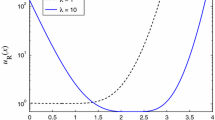Abstract
Using first- and second-order supersymmetric Darboüx formalism and starting with symmetric double well potential barrier we have obtained a class of exactly solvable potentials subject to moving boundary condition. The eigenstates are also obtained by the same technique.
Similar content being viewed by others
References
T K Jana and P Roy, Phys. Lett. A372, 2368 (2008)
J J Sakurai, Modern quantum mechanics (Addison Wesley Publishing Company, 1994) Chapter 4
Claude Cohen-Tannoudji, Bernard Diu and Franck Laloë, Quantum mechanics (Wiley Publication, 1977) Vol. 1
B Mielnik, J. Math. Phys. 25, 3387 (1984)
D J C Fernández, V Hussin and B Mielnik, Phys. Lett. A244, 309 (1998)
Asim Gangopadhyaya, Prasanta K Panigrahi and Uday P Sukhatme, Phys. Rev. A47, 2720 (1993)
John Sheridan and Walter Gordy, Phys. Rev. 79, 513 (1950)
H Margenau, Phys. Rev. 76, 1423 (1949)
Moshe Elitzur, arXiv:astro-ph/0105205v1, 11 May 2001
Kristen Rohlfs, Tools of radio astronomy (Springer-Verlag, Berlin and New York, 1986) p. 332
A C Cheung, D M Rank, C H Townes, D D Thornton and W J Welch, Phys. Rev. Lett. 21, 1701 (1968)
Feng Zhou, Zhuangqi Cao and Qishun Shen, Phys. Rev. A67, 062112 (2003)
C Quesne, arXiv:1106.1990v1 [math-ph], 10 June 2011
F Finkel, A Gonzalez-Lopez, N Kamran and M A Rodrigues, J. Math. Phys. 40, 3268 (1999)
D J C Fernández, J Negro and L M Nieto, Phys. Lett. A275, 338 (2000)
Acknowledgements
The authors would like to thank A Roychowdhury for fruitful discussion. One of the authors (Pinaki Patra) is grateful to CSIR (Govt. of India) for fellowship support. Also, the authors would like to thank the referee(s) for the valuable comments which improved the quality of the paper.
Author information
Authors and Affiliations
Corresponding author
Appendix
Appendix
In general, the form of γ(β) are:
for regions (1) and (2) and
for region (3) and symmetric case. Here Θs = [α s + 1 cosh A s sinh C s − α s cosh C s sinh A s].
For region (3) and antisymmetric case.
where \(\Theta_{\rm a}=(\alpha_{{\rm a}+1}\,{\rm sinh}\,A_{\rm a}\,{\rm cosh}\,C_{\rm a}-\alpha_{\rm a}\,{\rm cosh}\,A_{\rm a}\,{\rm sinh}\,C_{\rm a})^2\alpha\).
Rights and permissions
About this article
Cite this article
PATRA, P., DUTTA, A. & Saha, J.P. SUSY formalism for the symmetric double well potential. Pramana - J Phys 80, 21–30 (2013). https://doi.org/10.1007/s12043-012-0355-9
Received:
Revised:
Accepted:
Published:
Issue Date:
DOI: https://doi.org/10.1007/s12043-012-0355-9



